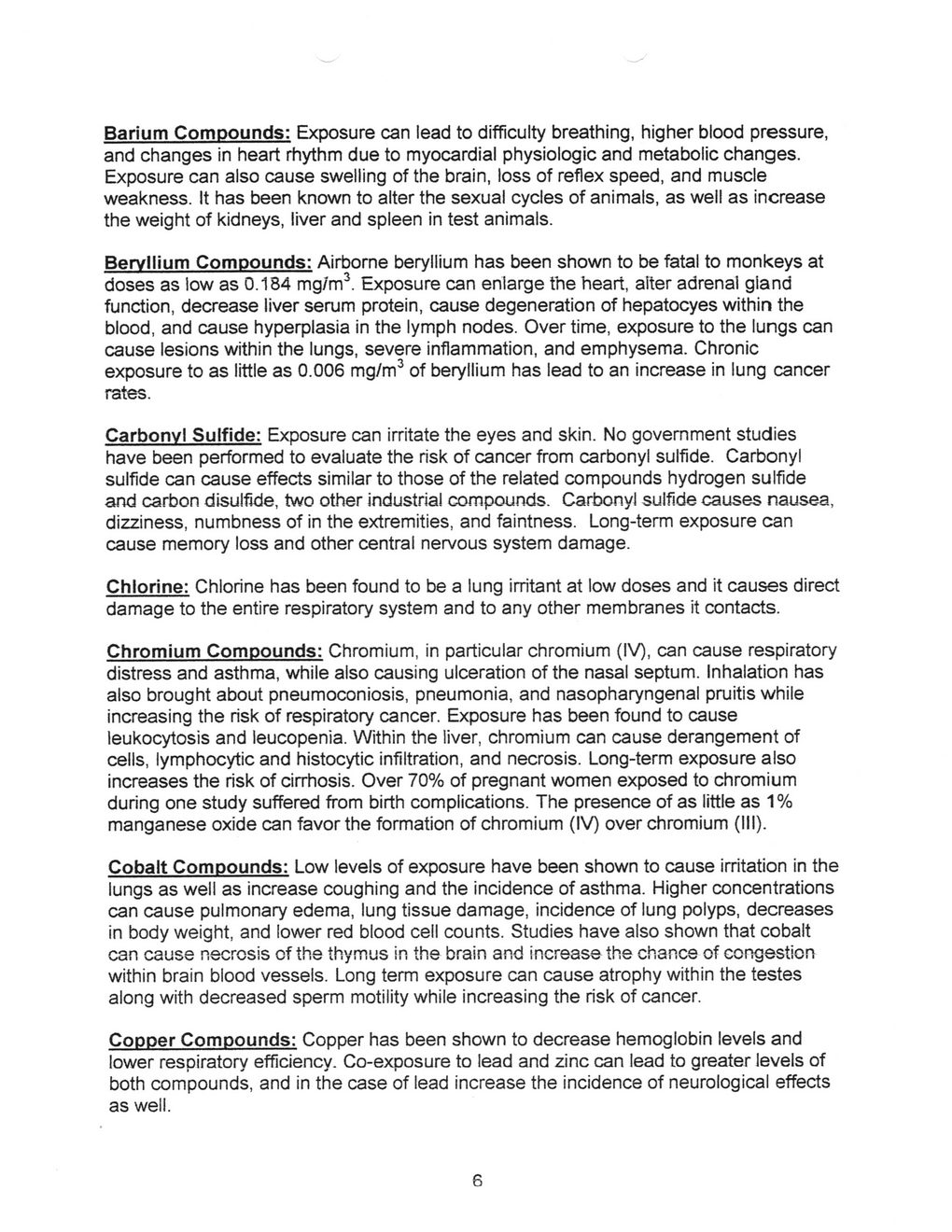This text was obtained via automated optical character recognition.
It has not been edited and may therefore contain several errors.
Barium Compounds: Exposure can lead to difficulty breathing, higher blood pressure, and changes in heart rhythm due to myocardial physiologic and metabolic changes. Exposure can also cause swelling of the brain, loss of reflex speed, and muscle weakness. It has been known to alter the sexual cycles of animals, as well as increase the weight of kidneys, liver and spleen in test animals. Beryllium Compounds: Airborne beryllium has been shown to be fatal to monkeys at doses as low as 0.184 mg/m3 Exposure can enlarge the heart, alter adrenal giand function, decrease liver serum protein, cause degeneration of hepatocyes within the blood, and cause hyperplasia in the lymph nodes. Over time, exposure to the lungs can cause lesions within the lungs, severe inflammation, and emphysema. Chronic exposure to as little as 0.006 mg/m3 of beryllium has lead to an increase in lung cancer rates. Carbonyl Sulfide: Exposure can irritate the eyes and skin. No government studies have been performed to evaluate the risk of cancer from carbonyl sulfide. Carbonyl sulfide can cause effects similar to those of the related compounds hydrogen sulfide and carbon disulfide, two other industrial compounds. Carbonyl sulfide causes nausea, dizziness, numbness of in the extremities, and faintness. Long-term exposure can cause memory loss and other central nervous system damage. Chlorine: Chlorine has been found to be a lung irritant at low doses and it causes direct damage to the entire respiratory system and to any other membranes it contacts. Chromium Compounds: Chromium, in particular chromium (IV), can cause respiratory distress and asthma, while also causing ulceration of the nasal septum. Inhalation has also brought about pneumoconiosis, pneumonia, and nasopharyngenal pruitis while increasing the risk of respiratory cancer. Exposure has been found to cause leukocytosis and leucopenia. Within the liver, chromium can cause derangement of cells, lymphocytic and histocytic infiltration, and necrosis. Long-term exposure also increases the risk of cirrhosis. Over 70% of pregnant women exposed to chromium during one study suffered from birth complications. The presence of as little as 1% manganese oxide can favor the formation of chromium (IV) over chromium (III). Cobalt Compounds: Low levels of exposure have been shown to cause irritation in the lungs as well as increase coughing and the incidence of asthma. Higher concentrations can cause pulmonary edema, lung tissue damage, incidence of lung polyps, decreases in body weight, and lower red blood cell counts. Studies have also shown that cobalt can cause necrosis of the thymus in the brain and increase the chance of congestion within brain blood vessels. Long term exposure can cause atrophy within the testes along with decreased sperm motility while increasing the risk of cancer. Copper Compounds: Copper has been shown to decrease hemoglobin levels and lower respiratory efficiency. Co-exposure to lead and zinc can lead to greater levels of both compounds, and in the case of lead increase the incidence of neurological effects as well. 8

Dupont Air Hearings Sierra-Club-Recommendations-(07)